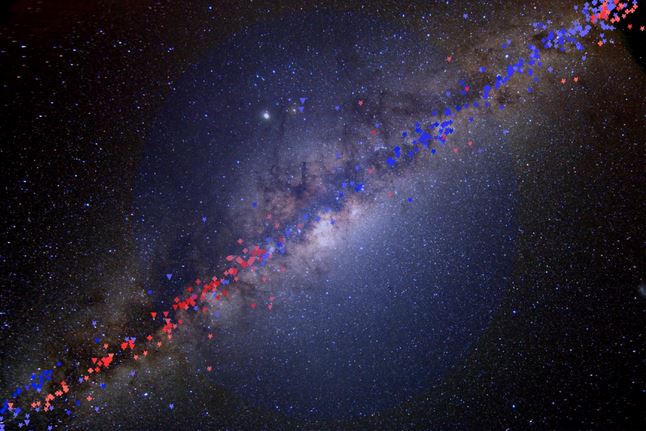Dark matter, material we cannot detect but believe exists because of its gravitational effects, is present at the heart of our galaxy the Milky Way, say researchers from Sweden, Germany, the Netherlands, Brazil and Spain.
Cosmologists and astrophysicists believe that dark matter is ubiquitous in the Universe. They say its existence in galaxies was compellingly established in the 1970s by measuring the rotation speed of stars and gas, which provides a way of accurately “weighing” the host galaxy and determining its total mass. Other techniques were also used to establish its existence.
According to these measurements, the visible matter in the Universe accounts for a small fraction of total weight, i.e. most of the Universe consists of dark matter.

The image displays the rotation curve tracers, which are color-coded according to their relative motion with respect to the sun – used in the publication over a photograph of the disc of the Milky Way as seen from the Southern Hemisphere. The spherically symmetric blue halo illustrates the dark matter distribution inferred from the analysis. (Credit: Serge Brunier / NASA. Image: Eurekalert)
While applying the same technique allows us to prove that dark matter exists in the outer parts of the Milky Way, establishing its presence in our galaxy’s innermost regions has proved very difficult.
The Milky Way has a diameter of about 100,000 light-years. We are approximately 26,000 light-years from the center. The closer we get to our galaxy’s center, the harder it becomes to measure the rotation of gas and stars with the required accuracy.
Dark matter is all around us
Now a team of scientists from the University of Amsterdam, the ICTP South American Institute for Fundamental Research in São Paulo, the Technische Universität München (TUM), Stockholm University, and the Universidad Autónoma de Madrid, have for the first time ever obtained a direct observational proof of the existence of dark matter in the heart of the Milky Way. This includes where the Earth is and our own “cosmic neighborhood”.
The team started off by creating the most comprehensive compilation of published measurements of the movements of gas and stars in the Milky Way. They then compared the rotation speeds that had been measured with what would be expected if they assumed that only luminous matter existed in the galaxy.
The comparison showed clearly that observed rotation would be impossible to explain unless a lot of dark matter were present around us, between us and in the galactic center.
Dr. Miguel Pato, who carried out the analysis at TU München, said:
“We know that dark matter is needed in our Galaxy to keep the stars and gas rotating at their observed speeds. However, we still do not know what dark matter is composed of. This is one of the most important science questions of our times.”
Now that the scientists have strong statistical evidence, even though it is just at small glactocentric distances, their results open a new door for determining how much dark matter there is inside the Milky Way.
In future observations, astronomers using this new method will be able to measure the distribution of dark matter in our galaxy with “unprecedented precision”, the researchers said.
Mr. Pato, who has since moved to the Oskar Klein Centre for Cosmoparticle Physics at Stockholm University, said:
“This will permit to refine the understanding of the structure and evolution of our Galaxy. And it will trigger more robust predictions for the many experiments worldwide that search for dark matter particles.”
Citation: “Evidence for dark matter in the inner Milky Way,” Fabio Iocco, Miguel Pato, Gianfranco Bertone. Nature Physics, advanced online publication, February 9, 2015. DOI: 10.1038/nphys3237
